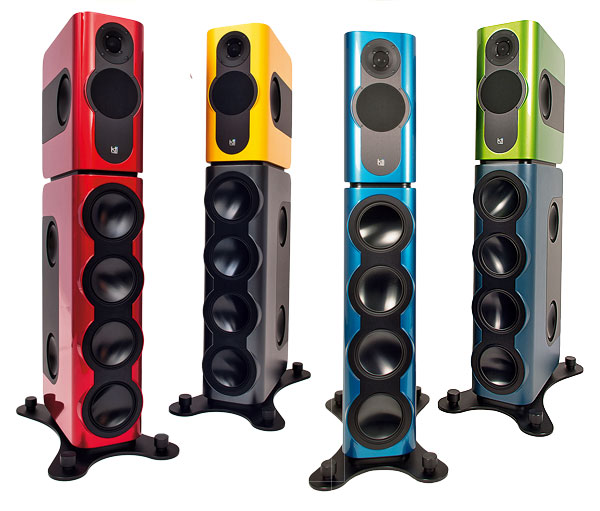Kii Audio THREE BXT Loudspeaker Page 2
So, with all that ability already in the 'head unit', it would have been easy to overcook things by adding another eight(!) bass units to each speaker, but it's to the credit of Kii Audio's designers, and their DSP, that there's nothing overblown or artificial going on here.
Rather, the THREE/BXT package hangs together as if it was designed as a single speaker, a supposition clear right from the sparkling opening notes of Britten's Piano Concerto, played by Howard Shelley and the BBC Philharmonic under Edward Gardner [Chandos CHAN10764; 96kHz/24-bit]. The percussive attack shows the speed and definition of the speakers, and their ability with the microdynamics of the music, and the balance between the solo instrument and the orchestra manages to sound entirely natural while retaining insight into both the score and performance.
On Your Marks...
This controlled, revealing nature is retained with the better-known Violin Concerto, the sweet tone of Tasmin Little's instrument soaring above the repeating motifs of the orchestra, after a darker opening laden with thrilling percussion.
Off to a good start, then, but still Donald Fagen's title track from Morph The Cat [Reprise 9362499752; 96kHz/24-bit] takes the listener by surprise, the Kii combo slamming into the track with a literal kick in the drums before the whole kit springs into life, soon joined by a satisfyingly grumbly and tight bass and the chiming keyboards, guitar and then brass. Fagen's voice has bags of character, with no sign of the sibilance some speakers can elicit, and as the track gets busier and the mix denser, the speakers just let it do so, with no confusion or compression.

Simple though its instrumentation may be, Iiro Rantala's take on 'Caravan', from his My History Of Jazz set [ACT 9531-2] still challenges systems with its speed and detail. It's driven by rhythms in the piano's left hand, and then violin on top, and these speakers give each instrument its space without making a song and dance about how clever they're being.
In other words all the quality here is subservient to the main task of making music rather than technical showboating, and the same goes for soundstaging – broad, deep and focused, it's just there, a stage on which the performances are set.
It's this combination of extreme ability combined with an almost insouciant ease that sets these Kii speakers apart. Even with the least complex music – in this case Keith Jarrett's The Köln Concert [ECM 1064/65; DSD64] – the quality of the Kii Audio speaker system is evident in the luminous piano sound and ambience, with the way each note decays into the space, Jarrett's exertions and the thud of the pedals laid out for inspection, as is the beauty of the tumbling musical expression. It's a recording so familiar as to be almost a hi-fi cliché, but via these speakers it's again captivating, almost mesmerising.
Bass Without Boom
You definitely get that 'bass you feel as well as hear' effect, but it's so well-controlled and tautly-defined that it can sound less than 'obvious'. Those BXT cabinets aren't really subwoofers after all, low though they go: instead they just extend the remarkable abilities of the THREE speakers to give an altogether more full-bodied sound, and all without drawing attention to themselves.

Pink Floyd's 'High Hopes' [The Division Bell; Legacy/Columbia, 96kHz/24-bit], just about shows everything the THREE/BXT combo can do, from the open and spacious ambience of the intro, with its sounds of nature and distant church bells already grabbing the listener's attention before the vocals and bass grumble. Again there's that sense of clarity, of listen-in detail even when the mix is dense but, above all, they just sweep you along with the music.
With the Swedish Radio SO/Ticciati recording of Berlioz's Roméo & Juliette [Linn CKD 521; 192kHz/24-bit], the ability of the THREE/BXT to convey a full-blooded orchestral event while maintaining finesse is much in evidence. The bass is rich, conveying the scale of the musical forces, but that tight control powers the piece along, with the instrumental textures – the richly metallic brass – crisply defined.
That deft low-down punch, delivered as part of the musical whole, is highly addictive. Playing the Neil Cowley Trio's 'Rooster Was A Witness' [The Face Of Mount Molehill, Naim NAIMCD 171], the sheer rhythmic drive of the relentless, metronomic drums and bass of Evan Jenkins and Rex Horan, forming the foundation for Cowley's percussive, charging piano, is every bit as exciting as I recall from seeing the group live. And that, simply, is what the Kii THREE/BXT does.
Hi-Fi News Verdict
This Kii combo is serious money, visually striking (you can have it in a range of colours, and even the THREEs in one shade and the BXTs in another) and for a hi-fi reviewer totally impractical, as everything but the source is in the speakers. But that last consideration counts not one jot compared to its effortless soundstaging and focus, remarkable levels of detail, power and dynamics, and breathtaking musicality. Fabulous!


























































